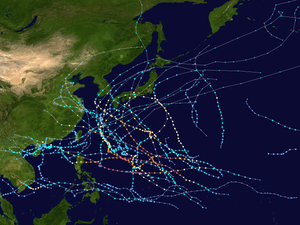
Back Temporada de tifones nel Pacíficu de 2018 AST Pazifische Taifunsaison 2018 German Pacifika tajfun-sezono 2018 Esperanto Temporada de tifones en el Pacífico de 2018 Spanish 2018年の台風 Japanese 2018년 태풍 Korean Musim taufan Pasifik 2018 Malay Temporada de tufões no Pacífico de 2018 Portuguese Сезон тихоокеанских тайфунов 2018 года Russian 2018 Pacific typhoon season SIMPLE
| 2018 Pacific typhoon season | |
|---|---|
 Season summary map | |
| Seasonal boundaries | |
| First system formed | December 29, 2017 |
| Last system dissipated | December 29, 2018 |
| Strongest storm | |
| Name | Kong-rey & Yutu |
| • Maximum winds | 215 km/h (130 mph) (10-minute sustained) |
| • Lowest pressure | 900 hPa (mbar) |
| Seasonal statistics | |
| Total depressions | 44, 1 unofficial |
| Total storms | 29, 1 unofficial |
| Typhoons | 13 |
| Super typhoons | 7 (unofficial) |
| Total fatalities | 793 total |
| Total damage | $30.54 billion (2018 USD) (Third-costliest Pacific typhoon season on record) |
| Related articles | |
The 2018 Pacific typhoon season was at the time, the costliest Pacific typhoon season on record, until the record was beaten by the following year. The season was well above-average, producing twenty-nine storms (including one that crossed over from the Eastern/Central Pacific), thirteen typhoons, seven super typhoons and six Category 5 tropical cyclones. The season ran throughout 2018, though most tropical cyclones typically develop between May and October. The season's first named storm, Bolaven, developed on January 3, while the season's last named storm, Man-yi, dissipated on November 28. The season's first typhoon, Jelawat, reached typhoon status on March 29, and became the first super typhoon of the year on the next day.
The scope of this article is limited to the Pacific Ocean, to the north of the equator between 100°E and the 180th meridian. Within the northwestern Pacific Ocean, there are two separate agencies that assign names to tropical cyclones, which can often result in a cyclone having two names, one from the JMA and one from PAGASA. The Japan Meteorological Agency (JMA) will name a tropical cyclone should it be judged to have 10-minute sustained wind speeds of at least 65 km/h (40 mph) anywhere in the basin, while the Philippine Atmospheric, Geophysical and Astronomical Services Administration (PAGASA) assigns names to tropical cyclones which move into or form as a tropical depression in their area of responsibility located between 135°E and 115°E and between 5°N and 25°N regardless of whether or not a tropical cyclone has already been given a name by the JMA. Tropical depressions that are monitored by the United States' Joint Typhoon Warning Center (JTWC) are given a number with a "W" suffix.